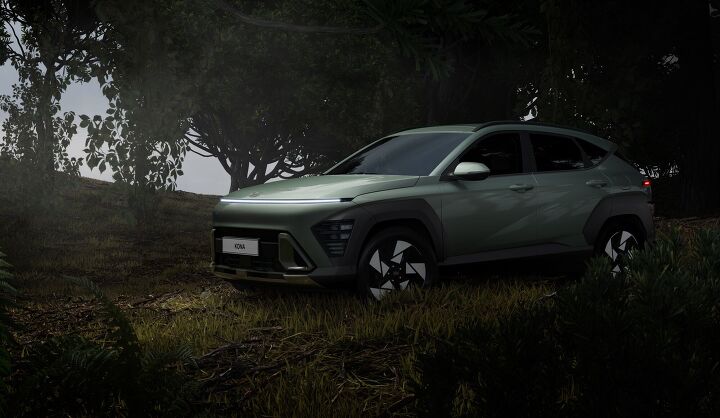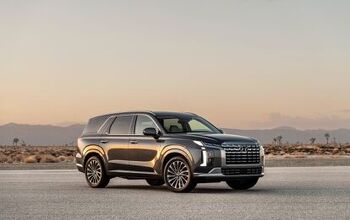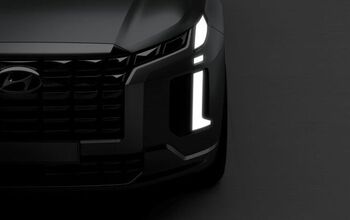Hyundai Shows New Kona

Just when you thought it was impossible for Hyundai illumination to get any thinner, along comes the new Kona. Unveiled today in Korea, this subcompact crossover will seek to build upon the successes of its predecessor – a model which sold over 90,000 units in America even during the topsy-turvy 2021 calendar year.
If you’re wondering, that performance puts it ahead of the Palisade (86.5k) that same year and not too far adrift of the popular Santa Fe (112k). The right-sized Tucson remained king in 2021 with a hair under 151,000 units find homes that year. But we digress.
Back to the new Kona. Even though this is a reveal in Seoul and not Alabama, one can take many inferences about what the vehicle will look like when it appears in our market. It will be available in four variants, including all-electric (EV), hybrid electric (HEV), internal combustion engine (ICE), and sporty N Line, with a universal architecture for all and styling tweaks for each. Given the popularity of all four around these parts, expect that quartet to appear on our shores – even if the rollout is performed in stages.
Hyundai says this Kona started with a design for the EV variant which was then adapted for the other models. This can be construed as an inverse of the norms. The new model has grown to 171.5 inches in length, nearly six inches longer than today’s car based on the EV variant. It also gained about an inch of width and 2.4 inches in wheelbase compared to last year’s car. That can’t-miss-it front illumination is apparently called a Seamless Horizon Lamp which will be pixelated on the EV so yer neighbors know you’ve sprung for the all-electric, plus give it a connection to those pixels found on the IONIQ 5 and IONIQ 6.
Mum’s the word on powertrain details but we can look to today’s lineup for clues. Pedestrian Kona models get a 2.0-liter four-banger making 147 horsepower while N Line trims are the recipient of a 1.6L turbo with 195 ponies and backed by a dual-clutch transmission. The Kona Electric utilizes a 201 hp electric motor paired with a 64 kWh battery, and hybrid variants of the Kona don’t exist in this market. It’s the latter note which is causing most people to hedge their bets as to if Hyundai will bring that powertrain to the American market with the new car.
The brand describes this new Kona’s interior as ‘EV-derived’ and it is indeed easy to draw parallels with the IONIQ 5’s minimalist interior. According to the PR bumf, there will be dual 12.3-inch displays plus a floating module and a raft of ambient lighting. Sounds like the IONIQ 5 to us. Also reminiscent – at least in the Korean-market model shown today – is a column-type shift-by-wire gear lever, presumably one which users need to twist like a candy cane to call upon forward or reverse motion.
More details of the next Hyundai Kona will be unveiled in the coming months.
[Images: Hyundai]
Become a TTAC insider. Get the latest news, features, TTAC takes, and everything else that gets to the truth about cars first by subscribing to our newsletter.

Matthew buys, sells, fixes, & races cars. As a human index of auto & auction knowledge, he is fond of making money and offering loud opinions.
More by Matthew Guy
Latest Car Reviews
Read moreLatest Product Reviews
Read moreRecent Comments
- Mike Bradley Autonomous cars were developed in Silicon Valley. For new products there, the standard business plan is to put a barely-functioning product on the market right away and wait for the early-adopter customers to find the flaws. That's exactly what's happened. Detroit's plan is pretty much the opposite, but Detroit isn't developing this product. That's why dealers, for instance, haven't been trained in the cars.
- Dartman https://apnews.com/article/artificial-intelligence-fighter-jets-air-force-6a1100c96a73ca9b7f41cbd6a2753fdaAutonomous/Ai is here now. The question is implementation and acceptance.
- FreedMike If Dodge were smart - and I don't think they are - they'd spend their money refreshing and reworking the Durango (which I think is entering model year 3,221), versus going down the same "stuff 'em full of motor and give 'em cool new paint options" path. That's the approach they used with the Charger and Challenger, and both those models are dead. The Durango is still a strong product in a strong market; why not keep it fresher?
- Bill Wade I was driving a new Subaru a few weeks ago on I-10 near Tucson and it suddenly decided to slam on the brakes from a tumbleweed blowing across the highway. I just about had a heart attack while it nearly threw my mom through the windshield and dumped our grocery bags all over the place. It seems like a bad idea to me, the tech isn't ready.
- FreedMike I don't get the business case for these plug-in hybrid Jeep off roaders. They're a LOT more expensive (almost fourteen grand for the four-door Wrangler) and still get lousy MPG. They're certainly quick, but the last thing the Wrangler - one of the most obtuse-handling vehicles you can buy - needs is MOOOAAAARRRR POWER. In my neck of the woods, where off-road vehicles are big, the only 4Xe models I see of the wrangler wear fleet (rental) plates. What's the point? Wrangler sales have taken a massive plunge the last few years - why doesn't Jeep focus on affordability and value versus tech that only a very small part of its' buyer base would appreciate?






































Comments
Join the conversation
One thing that H/K is doing here is to make everything else on the road look like yesterday's news. It's as if they are designing the 2030 Hyundai and releasing it seven years early.
I want to like the current Kona, especially the N, but from the rear wheels around the back I just don't understand what is going on.